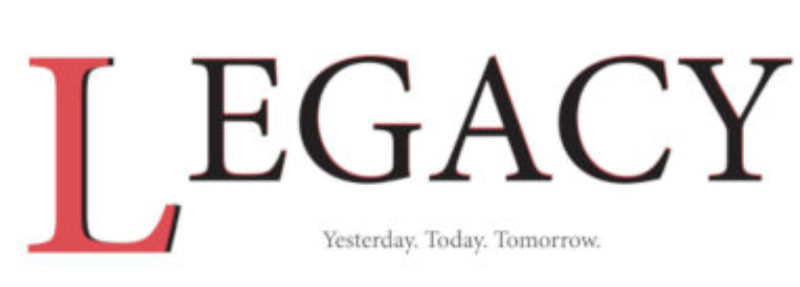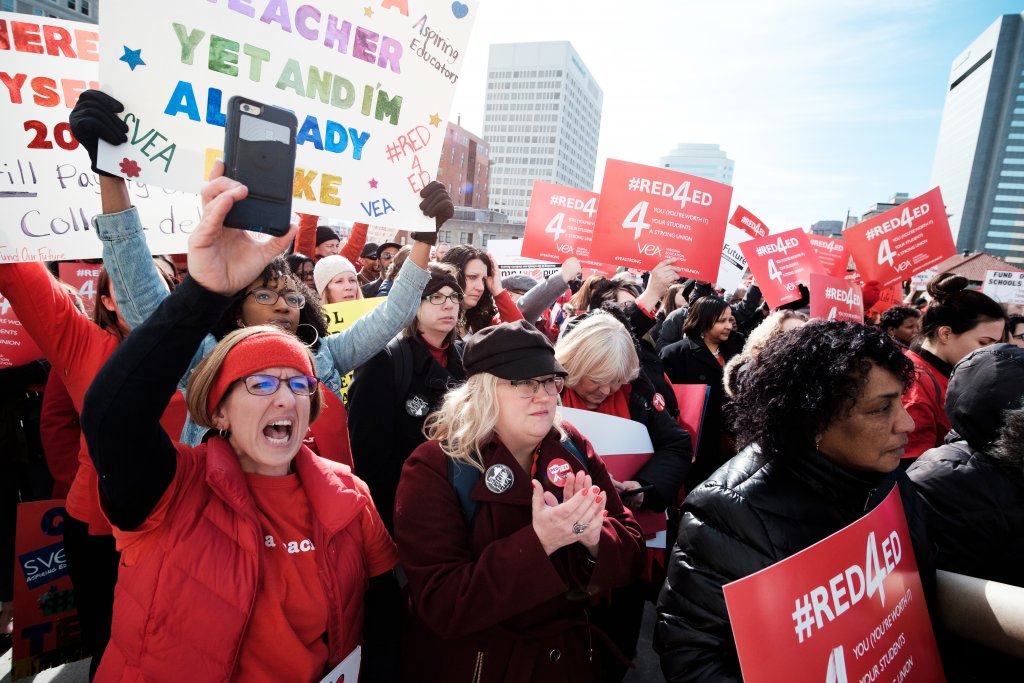Thousands of demonstrators rallied for better teacher pay and more public school funding during a January 2018 rally at the Capitol. Education groups still doubt that the state’s current spending on teacher salaries is enough to reverse current staffing shortfalls. (Ned Oliver/ Virginia Mercury)
By Kate Masters
(VM) – Since mid-July, teacher shortages have dominated discussions among Virginia’s local school boards.
In a meeting last week, Spotsylvania County Superintendent Kelly Guempel described the division’s staffing needs as “severe,” with 114 vacant teaching positions a week before the start of the school year. A few days earlier, Fairfax County Superintendent Michelle Reid informed parents the district was “working hard” to overcome a teacher shortage that’s left roughly 3% of classrooms unstaffed ahead of the fall semester.
In Richmond, Superintendent Jason Kamras described the number of vacancies as the worst he’s seen in nearly 30 years as an educator. As of July 29, the division was still struggling to fill 163 open teaching positions across the city’s elementary, middle and high schools — roughly double the number of vacancies as the previous year. On Monday, Henrico County reported a little more than 211 open teaching positions, and Chesterfield County had 243 vacancies left to fill as of Aug. 4, according to data from the division.
“Given our numbers and Chesterfield’s numbers and Henrico’s, we could be looking at a thousand vacancies just in our region,” Richmond School Board member Elizabeth Doerr said at a meeting last month. “Which is pretty crazy, just to let that sink in.”

While the number of unfilled teaching slots across Virginia can change by the day and even by the hour as districts race to fill positions ahead of the 2022-23 school year, they likely number in the thousands, according to state data. Last October, the Virginia Department of Education’s staffing and vacancy report listed more than 2,500 unfilled teaching positions across the state, and some divisions also reported a spike in departures at the end of the most current school year.
Virginia isn’t the only state to grapple with massive teacher shortages, which have reached crisis levels across the country, according to reporting by The Washington Post. But education advocates say the staffing shortfalls, compounded by the wave of resignations amid the COVID-19 pandemic, highlight lingering problems with pay, burnout and classroom conditions.
James Fedderman, president of the state’s largest teacher’s union, said some of the discontent among educators can be traced to the challenges of teaching during a public health crisis, from covering sick coworkers to catching students up to grade proficiency after a year or more out of the classroom. He also blamed intensifying culture wars around LGBTQ issues and so-called critical race theory — including an email tipline set up by Gov. Glenn Youngkin as a way for parents to report on “inherently divisive practices” in schools.
But education groups also say some factors contributing to the shortages have been decades in the making, especially when it comes to the state’s historically low teacher pay. A 2019 analysis by the Economic Policy Institute ranked Virginia as last in the country in terms of the “teacher wage penalty,” a measure referring to the gap in weekly salaries between teachers and other college-educated professionals.
Virginia’s latest two-year budget includes a 10% salary increase for teachers and other state employees, but some experts doubt it will be enough to make a serious dent in recruiting and retaining more teachers. Laura Goren, research director for The Commonwealth Institute for Fiscal Analysis, a progressive think tank that advocates for low-income Virginians, said most of the increase would be offset by inflation and even larger pay increases in other industries.
“It’s very welcome that the state is putting money into this,” Goren said. “But unfortunately, with rising costs of rent and gas and everything else, it’s too soon to know if it will really help with closing the pay gap between teachers and other professionals.”
The rush to cover classrooms before the start of the school year has also fueled new initiatives — and big spending — on recruitment and retention. In Virginia Beach, for example, the local school board approved a 6% raise for all new employees in addition to a $1,000 retention bonus expected in December. The division is also adding two mental health days to its employee benefits plan and reducing out-of-pocket health premium costs by up to 53%, which equates to yearly savings of roughly $4,219 for staff members with a family plan, according to spokesperson Natalie Allen.
With 123 instructional vacancies as of last week, the district is actually in a better position than it was at the same time last year, said Cheryl Woodhouse, the chief human resources officer for Virginia Beach Public Schools. But she attributed most of the progress to the district’s intensive hiring efforts, ranging from financial incentives to an aggressive outreach campaign.
At the end of last school year, Woodhouse said administrators set up recruitment booths at every one of the district’s high school graduations, an effort that yielded at least 200 new applications. Like other divisions, Virginia Beach has also tapped into the state’s reserve of retired employees to fill critical teacher shortage areas. And they’ve invested both time and money into heavy marketing campaigns, from radio ads to appearances on local TV stations.
“When we look at our success this year compared to some other districts, it really has come down to our recruitment efforts,” Woodhouse said. “And really recognizing that nothing is off the table.”
While Allen wasn’t able to quantify exactly how much the district had spent on new incentives and recruitment efforts, both she and Woodhouse said it was a significant increase compared to previous years. In many cases, schools are relying on federal pandemic aid for teacher bonuses and other hiring efforts, a strategy the Virginia Department of Education has specifically encouraged.

Agency spokesperson Charles Pyle also couldn’t provide an exact count of districts devoting federal funding to recruitment and retention initiatives, but said “a lot of them” are using such funds “and the number keeps growing.”
In many cases, the growing spending is fueling competition between districts for a dwindling supply of educators. In addition to a $2,000 sign-on bonus for new teachers (double for educators who focus on subjects with critical teaching shortages), the Richmond School Board recently approved a $6,000 moving stipend for those moving from more than 50 miles away. The goal, Kamras said, was to draw teachers from other parts of Virginia and even beyond.
“We have, in essence, an agreement with our colleagues in the counties to not poach from them and for them to not poach from us after a certain date,” he told school board members earlier this summer while proposing the moving stipend. “But we have now passed that date.”
“The pool of educators in Central Virginia is tight and it’s not likely to expand dramatically,” Kamras added. “So the key is going to be encouraging folks from outside a 50-mile radius to come and join the team.”
Some advocates, though, are skeptical that the current wave of incentives will be enough to keep teachers from leaving the field — or convince a new generation of students that education is a viable career path.
“Stipends are fine,” Fedderman said. “But what we really need to do is offer credible compensation for everything that educators are expected to do.”
Teacher shortages aren’t a new problem in Virginia, where retention and recruitment efforts have long been identified as a major weak spot. But VDOE has historically lacked the funding to implement significant hiring initiatives, according to Joan Johnson, the assistant superintendent for the agency’s Department of Teacher Education and Licensure. Because of that, she said federal aid has been a major boon for the state, allowing education officials to embark on several new projects.
For the first time ever, the state is planning to release a new strategic plan for recruitment and retention, as well as launching a million-dollar marketing campaign to promote the profession, with ads focused on the positive impact of teachers and alternative pathways for Virginians to join the field. Earlier this year, VDOE announced a grant program to help local divisions pay tuition for employees interested in earning a teaching license. The agency is also launching an apprenticeship program that will pay teaching candidates while they’re getting certified, giving them a chance to gain classroom experience in the process.
“This is really the first time we’ve had the resources and this kind of direct attention on recruitment and retention,” Johnson said. “That has never been the main focus of VDOE.”
Among Virginia’s administrators, teachers and other education advocates, there’s near-universal acknowledgement that the loss of permanent educators will be a detriment to students. Like other districts, Kamras said Richmond will have to resort to long-term substitutes and larger class sizes if it can’t fill more teaching positions before the start of the school year. Throughout the pandemic, many divisions have sent licensed office administrators to fill in for absent teachers or relied more heavily on provisionally licensed educators without deep classroom experience.
“When our School Quality Office works with school divisions that aren’t meeting our state benchmarks, that’s always a big factor — the percentage of teachers in a school who lack full certification or are long-term substitutes,” Pyle said.



